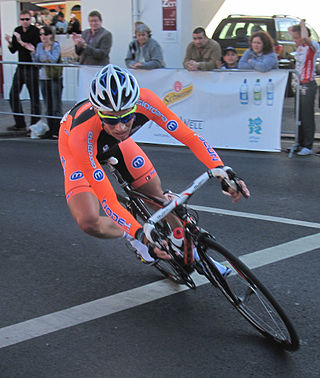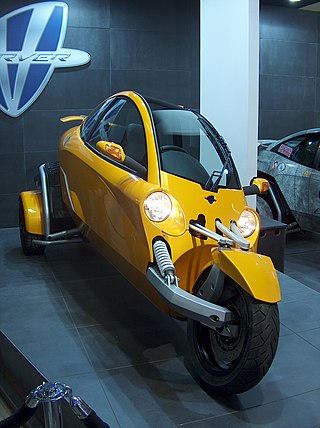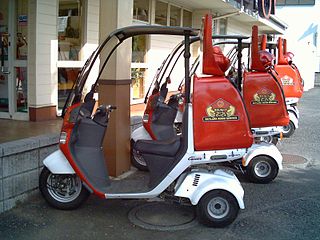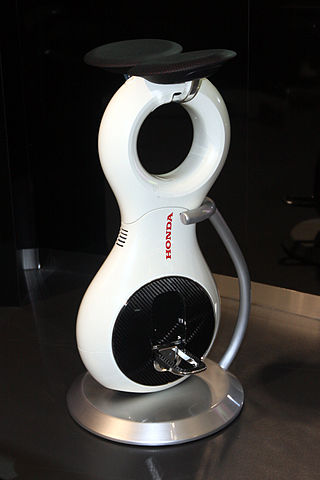

The Honda UNI-CUB is a concept 2-axis self-balancing personal transporter for use in barrier-free indoor environments, and shown at the Osaka Motor Show 2013.


The Honda UNI-CUB is a concept 2-axis self-balancing personal transporter for use in barrier-free indoor environments, and shown at the Osaka Motor Show 2013.
As a successor to the 2009 Honda U3-X, it was demonstrated at the Osaka Motor Show 2013. A launch date has not yet been announced. [1] [2]
Controlled by weight-shifting, similar manner as that of the Segway PT, the unit is fully self-balancing and can move in any direction, including sideways. [3]
There are two wheels, the larger driving wheel for travelling in a forward direction, and a trailing steering wheel at 90 degrees to this one. Both the drive wheel and the steering wheel however are constructed of multiple smaller 'planet' wheels that allow the wheel to be moved laterally. When moving forward the main wheel will be powered and the smaller planet wheels on the steering wheel will rotate to avoid the steering wheel dragging. To turn the steering wheel is rotated. To balance from side to side, or to self-balance laterally, the planet wheels on the drive wheel will be powered appropriately. [4]
Measuring 510 x 315 x 620 mm and weighing 25 kg, the UNI-CUB is powered by a lithium-ion battery and has a 6 km/h top speed and 6 km range. The seat height is 620 mm, while footrests are designed to double as support stands. [5]

A Segway is a two-wheeled, self-balancing personal transporter device invented by Dean Kamen. It is a registered trademark of Segway Inc. It was brought to market in 2001 as the Segway HT, and then subsequently as the Segway PT.HT is an initialism for "human transporter" and PT for "personal transporter."

A tricycle, sometimes abbreviated to trike, is a human-powered three-wheeled vehicle.

An electric unicycle is a self-balancing personal transporter with a single wheel. The rider controls speed by leaning forwards or backwards, and steers by twisting or tilting the unit side to side. The self-balancing mechanism uses accelerometers and gyroscopes. Most manufacturers of EUCs are based out of China, including Segway, Inmotion, Kingsong, Begode, and Leaperkim.

Steering is the control of the direction of motion or the components that enable its control. Steering is achieved through various arrangements, among them ailerons for airplanes, rudders for boats, cylic tilting of rotors for helicopters, and many more.

A gyrocar is a two-wheeled automobile. The difference between a bicycle or motorcycle and a gyrocar is that in a bike, dynamic balance is provided by the rider, and in some cases by the geometry and mass distribution of the bike itself, and the gyroscopic effects from the wheels. Steering a motorcycle is done by precessing the front wheel. In a gyrocar, balance was provided by one or more gyroscopes, and in one example, connected to two pendulums by a rack and pinion.

A tilting three-wheeler, tilting trike, leaning trike, or even just tilter, is a three-wheeled vehicle and usually a narrow-track vehicle whose body and or wheels tilt in the direction of a turn. Such vehicles can corner without rolling over despite having a narrow axle track because they can balance some or all of the roll moment caused by centripetal acceleration with an opposite roll moment caused by gravity, as bicycles and motorcycles do. This also reduces the lateral acceleration experienced by the rider, which some find more comfortable than the alternative. The narrow profile can result in reduced aerodynamic drag and increased fuel efficiency. These types of vehicles have also been described as "man-wide vehicles" (MWV).
Power steering is a system for reducing a driver's effort to turn a steering wheel of a motor vehicle, by using a power source to assist steering.

The Honda Gyro is a family of small, three-wheeled motorcycles sold primarily in Japan, and often used for delivery or express service.

Bicycle and motorcycle dynamics is the science of the motion of bicycles and motorcycles and their components, due to the forces acting on them. Dynamics falls under a branch of physics known as classical mechanics. Bike motions of interest include balancing, steering, braking, accelerating, suspension activation, and vibration. The study of these motions began in the late 19th century and continues today.

A dicycle is a vehicle with two parallel wheels, side by side, unlike single-track vehicles such as motorcycles and bicycles, which have two wheels inline. Originally used to refer to devices with large wheels and pedals, the term is now used in relation to powered self-balancing scooters with smaller wheels and no pedals such as the Segway PT and the self-balancing hoverboard.

The Uno is a novel self-balancing electric motorcycle using two wheels side by side. The Uno III adds a third wheel that allows it to transform into a tricycle.

The Personal Urban Mobility and Accessibility (PUMA) was an experimental electrically powered road vehicle created by Segway and adopted by General Motors as a concept vehicle representing the future of urban transportation. It operates on two wheels placed side by side, a layout that differs in placement from motorcycles which instead have their two wheels placed at the front and rear.
Toyota concept vehicles are transportation devices manufactured or designed by automobile company Toyota from 2000 to 2009. As their name suggests, these vehicles were concepts, and, as such, many were never released to dealerships. Many were developed in conjunction with other corporations such as Sony or Subaru.

A zero-turn riding lawn mower is a standard riding lawn mower with a turning radius that is effectively zero when the two drive wheels rotate in opposite direction, like a tank turning in place.

The Honda U3-X is an experimental self-balancing one-wheeled personal transporter shown in 2009.

Individual-wheel drive (IWD) is a wheeled vehicle with a drivetrain that allows all wheels to receive torque from several motors independent of each other. The term was coined to identify those electric vehicles whereby each wheel is driven by its own individual electric motor, as opposed to conventional differentials.
Torque vectoring is a technology employed in automobile differentials that has the ability to vary the torque to each half-shaft with an electronic system; or in rail vehicles which achieve the same using individually motored wheels. This method of power transfer has recently become popular in all-wheel drive vehicles. Some newer front-wheel drive vehicles also have a basic torque vectoring differential. As technology in the automotive industry improves, more vehicles are equipped with torque vectoring differentials. This allows for the wheels to grip the road for better launch and handling.
Crosswind stabilization (CWS) is a relatively new advanced driver-assistance system in cars and trucks that was first featured in a 2009 Mercedes-Benz S-Class. CWS assists drivers in controlling a vehicle during strong wind conditions such as driving over a bridge or when overtaking a semi-truck. CWS uses yaw rate, lateral acceleration, steering angle, and velocity sensors to determine how much assistance to give the driver in a certain scenario whether it be at different speeds or while turning. Using different components throughout the vehicle like brakes, differentials, and suspension, CWS can implement the readings from force sensors to properly assist the driver in a given situation.

A self-balancing scooter is a self-balancing personal transporter consisting of two motorized wheels connected to a pair of articulated pads on which the rider places their feet. The rider controls the speed by leaning forward or backward, and direction of travel by twisting the pads.

A personal transporter is any of a class of compact, mostly recent, motorised micromobility vehicle for transporting an individual at speeds that do not normally exceed 25 km/h (16 mph). They include electric skateboards, kick scooters, self-balancing unicycles and Segways, as well as gasoline-fueled motorised scooters or skateboards, typically using two-stroke engines of less than 49 cc (3.0 cu in) displacement. Many newer versions use recent advances in vehicle battery and motor-control technologies. They are growing in popularity, and legislators are in the process of determining how these devices should be classified, regulated and accommodated during a period of rapid innovation.